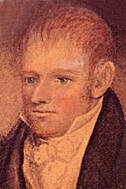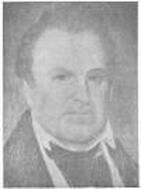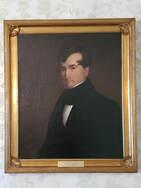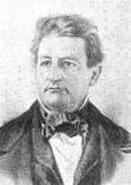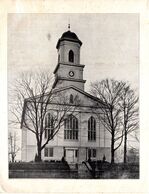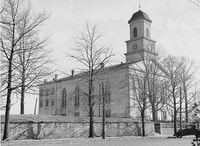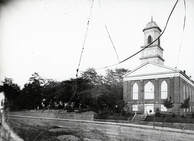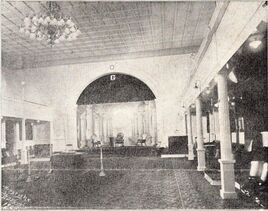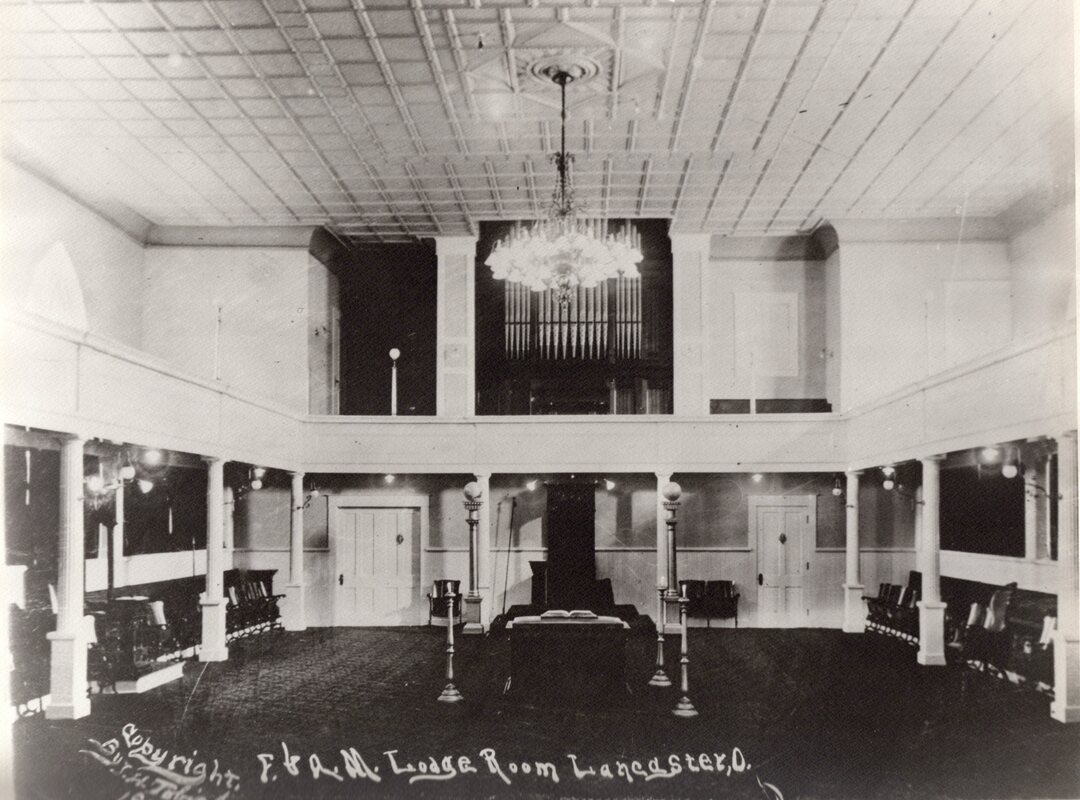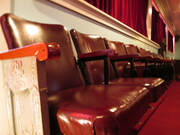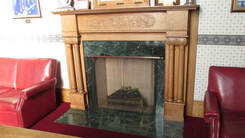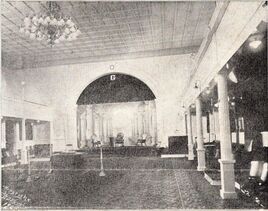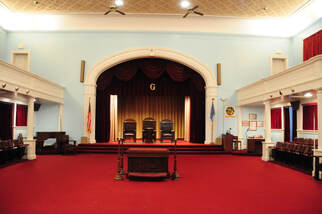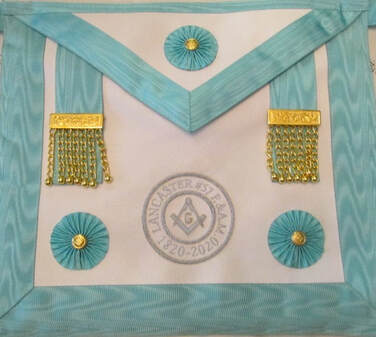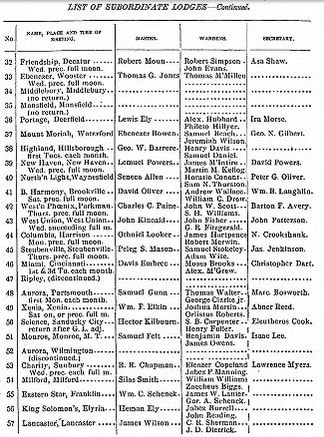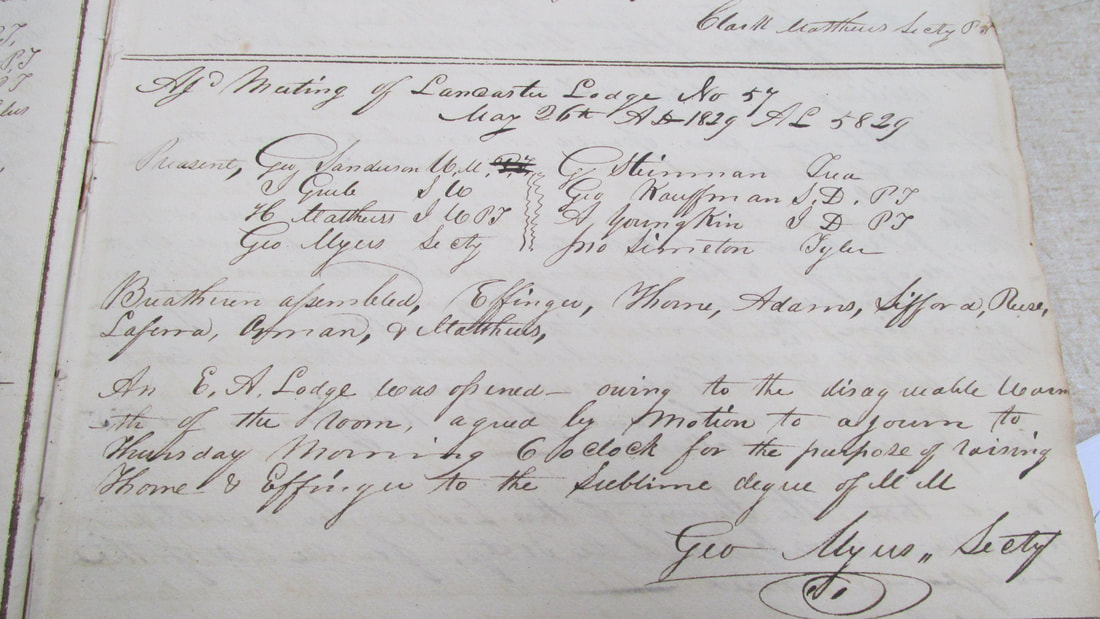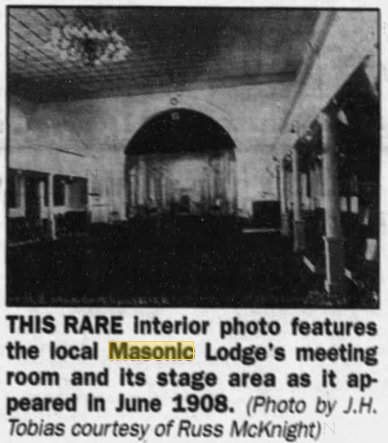IN THE BEGINNING ...
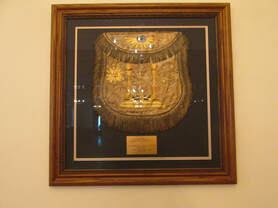 Apron belonging to WM Charles Sherman
Apron belonging to WM Charles Sherman
(Excerpted from Freemasonry in Lancaster, Ohio 1820-2008 by James C. Draper, KYCH)
There were 23 States in the Union, James Monroe was the President, and Ohio had but 29 Masonic lodges. The closest one was Pickaway #23, some twenty miles away in Circleville. Travel was on foot, horseback, or by horse and wagon. A horse at a walk would take about four hours to travel between Lancaster and Circleville. Today it takes about a half hour by automobile.
In late 1819, a group of prominent men & Masons in Lancaster, being desirous of establishing a Lodge here, petitioned the Grand Lodge of Ohio for a Dispensation. Though oddly not recorded in the Grand Lodge Proceedings of December 1819, the matter was clearly discussed and approved, for the last page of the Proceedings for 1819 lists all the Lodges in Ohio, and Lancaster #57 is the last one listed.
The Dispensation was received on 15 January 1820, with the following officers listed:
Dr. James Wilson Worshipful Master
Judge Charles Sherman Senior Warden
Jacob D. Deitrick Junior Warden
George Ring Treasurer
Nathaniel C. Gilman Secretary
<vacant> Senior Deacon
<vacant> Junior Deacon
H. B. Joy Tyler
The first Stated Communication (Under Dispensation, or U.D.) was held on Tuesday, 18 January 1820 in the North Jury Room of the Courthouse, with the following men chosen to fill the vacant seats:
Levi Ring Senior Deacon
Albanus Sawyer Junior Deacon
In addition to the aforementioned Officers, the following Brethren were present for the first Communication: [Samuel] Wheeler, [Samuel] Blaisdel, [Hiram] Hanson, [Christian] Rokohl, [Hugh] Boyle, and Visiting Bro. G[eorge]. Sanderson.
Petitions were presented from Gottlieb Steinman, Bro. Rokohl voucher; Stephen Yale, Bro Geo. King voucher, A. Younkin voucher; Jacob Lutz, John Noble, Bro. Deetrick[sic] voucher; Thomas Cushing, Nathaniel Gilman voucher. The Worshipful Master appointed a committee of Bros. Sherman, Boyle, and G. Ring to enquire in to the character of the applicants and report back at the next meeting.
The first order of business was that on motion a committee be appointed “to procure 12 split bottomed chairs for the use of the Lodge.”
Bro George Sanderson, a Fellowcraft, petitioned the Lodge to be raised to the sublime degree of Master Mason. A committee was appointed to examine Bro Sanderson to determine whether he had made due proficiency in the former degrees.
It was moved that the by-laws be so far dispensed with as to admit Bros. Samuel Wheeler and Albanus Sawyer as members without paying the usual fees, which was unanimously approved.
Bro. J. Parker from Paramuthia Lodge (Athens, Ohio) was admitted to a seat.
There being no further business, the “Lodge closed in harmony at 9 o’clock.”
The Lodge is Chartered
Throughout 1820 there were a multitude of Stated and Special Communications, and many Masons received as members, and many more receiving the degrees of Freemasonry. In November of 1820, Lancaster Lodge #57 petitioned the Grand Lodge of Ohio for a Charter, which would give them full privileges and voting rights at Grand Lodge. This petition was approved, and a Charter granted on 15 December 1820.
On St John’s Day in December 1820, we were officially constituted as a Lodge, with the following officers installed:
Dr. James Wilson Worshipful Master
Charles Sherman Senior Warden
Jacob D. Deitrick Junior Warden
George Ring Treasurer
Thomas H. Cushing Secretary
Steven Yale Senior Deacon
John Noble Junior Warden
Henry B. Joy Tyler
CHARTER MEMBERS other than officers: Henry Abrams, George Binkley, Jacob Binkley, Samuel Blaisdale, Hugh Boyle, George Busby, Abram Carter, Ezra Clark, William Duffield, Nathaniel Gilman, Hiram Hanson, Alexander Harrison, Andrew Henkel, Thomas Littlefield, William Irvin, John Marguot, Isaac Mason, Edward Murphy, James Rice, Levi Ring, Christian Rokohl, Albanus Sawyer, Lewis Shide, James A. Smith, John Smith, and Charles Stevens.
Since that first meeting in the North Jury Room of the Courthouse, Lancaster Lodge #57 has been a veritable “Who’s Who” of distinguished men and leaders of the community, and have from time to time received distinguished men such as Bro. DeWitt Clinton, Governor of New York, in 1825. Among our noteworthy members are Judge Charles Sherman (father of Gen. Wm. Tecumseh Sherman) of the Ohio Supreme Court and Grand Master of Ohio; Jacob Dietrick, magistrate, postmaster, and Grand Senior Deacon the Grand Lodge of Ohio; General George Sanderson, member of the Ohio General Assembly, and Grand Marshal of the Grand Lodge of Ohio; Judge William Irvin, Ohio Supreme Court judge and Grand Master of Ohio; and many, many more.
Many well-known men of early Lancaster whose names are known to this day were members of the Lodge, including architect Daniel Sifford, and Samuel Effinger. Bro. Sifford was the architect of numerous stately homes and buildings in Lancaster, including St. Johns' Episcopal Church and the Maccracken House (today the Georgian Museum).
There were 23 States in the Union, James Monroe was the President, and Ohio had but 29 Masonic lodges. The closest one was Pickaway #23, some twenty miles away in Circleville. Travel was on foot, horseback, or by horse and wagon. A horse at a walk would take about four hours to travel between Lancaster and Circleville. Today it takes about a half hour by automobile.
In late 1819, a group of prominent men & Masons in Lancaster, being desirous of establishing a Lodge here, petitioned the Grand Lodge of Ohio for a Dispensation. Though oddly not recorded in the Grand Lodge Proceedings of December 1819, the matter was clearly discussed and approved, for the last page of the Proceedings for 1819 lists all the Lodges in Ohio, and Lancaster #57 is the last one listed.
The Dispensation was received on 15 January 1820, with the following officers listed:
Dr. James Wilson Worshipful Master
Judge Charles Sherman Senior Warden
Jacob D. Deitrick Junior Warden
George Ring Treasurer
Nathaniel C. Gilman Secretary
<vacant> Senior Deacon
<vacant> Junior Deacon
H. B. Joy Tyler
The first Stated Communication (Under Dispensation, or U.D.) was held on Tuesday, 18 January 1820 in the North Jury Room of the Courthouse, with the following men chosen to fill the vacant seats:
Levi Ring Senior Deacon
Albanus Sawyer Junior Deacon
In addition to the aforementioned Officers, the following Brethren were present for the first Communication: [Samuel] Wheeler, [Samuel] Blaisdel, [Hiram] Hanson, [Christian] Rokohl, [Hugh] Boyle, and Visiting Bro. G[eorge]. Sanderson.
Petitions were presented from Gottlieb Steinman, Bro. Rokohl voucher; Stephen Yale, Bro Geo. King voucher, A. Younkin voucher; Jacob Lutz, John Noble, Bro. Deetrick[sic] voucher; Thomas Cushing, Nathaniel Gilman voucher. The Worshipful Master appointed a committee of Bros. Sherman, Boyle, and G. Ring to enquire in to the character of the applicants and report back at the next meeting.
The first order of business was that on motion a committee be appointed “to procure 12 split bottomed chairs for the use of the Lodge.”
Bro George Sanderson, a Fellowcraft, petitioned the Lodge to be raised to the sublime degree of Master Mason. A committee was appointed to examine Bro Sanderson to determine whether he had made due proficiency in the former degrees.
It was moved that the by-laws be so far dispensed with as to admit Bros. Samuel Wheeler and Albanus Sawyer as members without paying the usual fees, which was unanimously approved.
Bro. J. Parker from Paramuthia Lodge (Athens, Ohio) was admitted to a seat.
There being no further business, the “Lodge closed in harmony at 9 o’clock.”
The Lodge is Chartered
Throughout 1820 there were a multitude of Stated and Special Communications, and many Masons received as members, and many more receiving the degrees of Freemasonry. In November of 1820, Lancaster Lodge #57 petitioned the Grand Lodge of Ohio for a Charter, which would give them full privileges and voting rights at Grand Lodge. This petition was approved, and a Charter granted on 15 December 1820.
On St John’s Day in December 1820, we were officially constituted as a Lodge, with the following officers installed:
Dr. James Wilson Worshipful Master
Charles Sherman Senior Warden
Jacob D. Deitrick Junior Warden
George Ring Treasurer
Thomas H. Cushing Secretary
Steven Yale Senior Deacon
John Noble Junior Warden
Henry B. Joy Tyler
CHARTER MEMBERS other than officers: Henry Abrams, George Binkley, Jacob Binkley, Samuel Blaisdale, Hugh Boyle, George Busby, Abram Carter, Ezra Clark, William Duffield, Nathaniel Gilman, Hiram Hanson, Alexander Harrison, Andrew Henkel, Thomas Littlefield, William Irvin, John Marguot, Isaac Mason, Edward Murphy, James Rice, Levi Ring, Christian Rokohl, Albanus Sawyer, Lewis Shide, James A. Smith, John Smith, and Charles Stevens.
Since that first meeting in the North Jury Room of the Courthouse, Lancaster Lodge #57 has been a veritable “Who’s Who” of distinguished men and leaders of the community, and have from time to time received distinguished men such as Bro. DeWitt Clinton, Governor of New York, in 1825. Among our noteworthy members are Judge Charles Sherman (father of Gen. Wm. Tecumseh Sherman) of the Ohio Supreme Court and Grand Master of Ohio; Jacob Dietrick, magistrate, postmaster, and Grand Senior Deacon the Grand Lodge of Ohio; General George Sanderson, member of the Ohio General Assembly, and Grand Marshal of the Grand Lodge of Ohio; Judge William Irvin, Ohio Supreme Court judge and Grand Master of Ohio; and many, many more.
Many well-known men of early Lancaster whose names are known to this day were members of the Lodge, including architect Daniel Sifford, and Samuel Effinger. Bro. Sifford was the architect of numerous stately homes and buildings in Lancaster, including St. Johns' Episcopal Church and the Maccracken House (today the Georgian Museum).
Four Grand Masters of Ohio
Lancaster Lodge holds the unusual distinction of being the only Lodge in Ohio to have no less than four of its Masters serve as Grand Master of Ohio: Charles Sherman in 1824, William Irvin in 1825, William James Reese 1834-1842, and Michael Z. Kreider 1847-49. Additionally, Joseph Grubb – who served as Lancaster’s first mayor in 1831 and who was a charter member of the Lodge – served as Grand Senior Deacon, and went on to become the Grand Master of the Grand Lodge of Arkansas in 1844. Fifteen of our officers went on to serve as Officers of the Grand Lodge. In 2027 - the Great Architect willing - we will have the 5th Ohio Grand Master to come from Lancaster Lodge.
WHITHER THE LODGE?
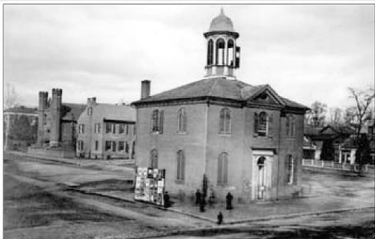
Courthouse
The Lodge was organized and first met in the North Jury Room of the Courthouse, which stood in what is today the middle of the intersection of Main & Broad Streets. The Lodge met here from its inception in 1820 until 1824.
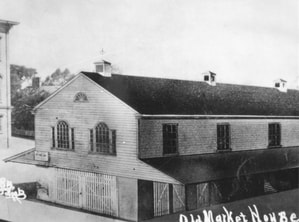
Market House
In 1824, a new Market House was built immediately adjacent to the Courthouse, where the fountain stands today. On St John’s Day of December 1824, Charles Sherman – who was both Master of the Lodge and Grand Master of Ohio – consecrated the new Lodge room in the Market House. It was here that the Masons of Lancaster met, as well as from elsewhere, and where they could safely meet during the Morgan years. Thankfully, the Morgan era never affected Freemasonry in Ohio. It was in the Market House location that Lancaster’s York Rite was formed.
By 1868 the Market House had outlived its usefulness, having become too small as a meeting place not just for the Masons, but for the people of Lancaster, and was torn down.
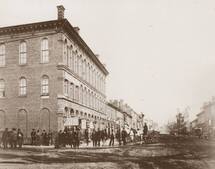
Rising Block
In June 1868, the Lodge moved into leased rooms on the third floor of the Rising Building, located on the NE corner of Main & Columbus. (In the mid 1900s the third floor was removed. In 2019 the ground floor is home to O’Huid’s Gaelic Pub.)
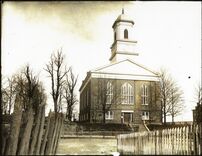 Methodist Church, ca. 1898.
Methodist Church, ca. 1898.
Methodist Episcopal Church
In 1907 the space at the Rising Block was becoming too small for the growing Lodge membership, at the same time as Lancaster Methodists were experiencing the identical problem. The Methodist Episcopal congregation – having outgrown their church building - built a new church at the top of Wheeling Hill, which left their old building available. In 1907, the Lancaster Temple Association purchased the former Methodist Episcopal Church, which was consecrated and dedicated as a Masonic Hall on June 24, 1908. The church had been built in 1838 in a rare American Colonial Greek Revival architectural style.
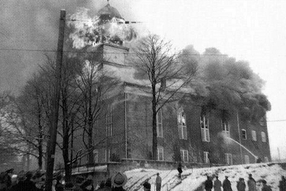 15 December 1944
15 December 1944
On 15 December 1944 the building tragically caught fire. Fortunately, there were a number of Brethren in the building at the time, and were able to save the entire Library, which had been given to the Lodge by Judge John Graybill Reeves. There are many books that still bear heavy scorching. Because the hydrants were frozen, there was no water available to extinguish the fire right away, despite the Engine House being literally next door to the Lodge. By the time some hydrants were thawed, it was too late to save the building. Everything – except the books from the Lodge’s library – was destroyed, including the 1883 Hook & Hastings pipe organ.
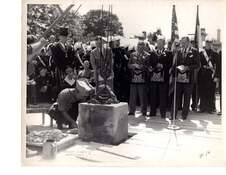 Cornerstone is laid in 1946.
Cornerstone is laid in 1946.
The Lodge moved into temporary facilities in the Hannan Building at 201 South High St. In 1945, work began in earnest to raise funds to rebuild what had been considered the finest example of Greek Revival [church] architecture in Ohio. Construction began in 1946 with the cornerstone laid to rebuild the building exactly as it was, down to precisely replicating the woodwork. The Lodge room was rebuilt nearly identical to the way it appeared when it was a Methodist Church, though the stage area was designed to include stage rigging and a theatrical stage dimmer array. Where once had been a pipe organ was a semicircular room for a choir, and above it a projection room for showing two-reel movies. The front steps were also redesigned. Instead of a single flight of steps to the front door, the steps are configured in three groups, consisting of three, five, and seven steps, with Masonic symbols embedded.
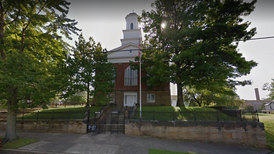
The completed rebuilt Colonial Gothic Lodge was dedicated and consecrated in 1953. This magnificent building continues to be the home of Freemasonry in Lancaster. It is one of very few Lodges in Ohio to retain the use of an organist to provide music for the conferring of degrees as well as for Stated meetings.
For 200 years, Lancaster Lodge #57 has had among its members distinguished leaders of our community; some men have held high public office while others were skilled hard-working tradesmen. Each man humbly doing his part to make our town a better place, teaching us to improve ourselves and the lives of those in our community.
For 200 years, Lancaster Lodge #57 has had among its members distinguished leaders of our community; some men have held high public office while others were skilled hard-working tradesmen. Each man humbly doing his part to make our town a better place, teaching us to improve ourselves and the lives of those in our community.
The Lancaster Masonic Temple is home to
Lancaster Lodge #57 F. & A.M. (chartered 1820)
Lancaster Chapter #11 Royal Arch Masons (chartered 1825)
Lancaster Council #3 Royal & Select Masters (chartered 1830/1902)
Lancaster Commandery #2 Knights Templar (chartered 1838)
GRAND LODGE HALL TO BE BUILT IN LANCASTER
The Grand Lodge of Ohio was formed in 1808 but had no official home. It frequently met in Chillicothe, which was the state capital from 1803-1810 and 1812-16, as well as in Columbus, which became the capital city in 1816. Grand Lodge also met in Lancaster with some frequency, especially when Sherman, Irvin, Kreider, and Reese were Grand Master. In 1838 the Grand Lodge adopted a Resolution to establish a permanent home for the Grand Lodge. In a vote to determine the location of the new Grand Lodge Hall, Lancaster received 65 votes and Columbus received 5.
Two lots were purchased, and ground was broken and the cornerstone laid on the SW corner of North Broad & Mulberry in 1841. Brother Daniel Sifford was appointed Superintendent of Works to oversee the project. Funds were raised, with Lancaster contributing a very significant amount, and Lodges around the state were requested to contribute. Not long after the foundation was completed, a major financial depressions swept the nation, and financing for the project all but dried up. Lancaster Masons had invested heavily in the project, and were deeply saddened at its demise. A few years later, the foundation was dismantled, and the cornerstone and its contents retrieved and maintained in the possession of Lancaster Lodge until 1969 when the Stone was transferred to the Grand Lodge Museum.
Today the site is occupied by the Fairfield County District Library main branch and its north parking lot.
CAPITULAR MASONRY IN LANCASTER
Charles Sherman received the Royal Arch degrees some time in the early 1820s on his many visits outside Lancaster. Upon his return, he immediately sought to establish a Chapter of Royal Arch Masons in Lancaster. The Chapter organized under Dispensation 12 January 1825, and received its Charter as Lancaster Chapter #11 R.A.M. one year later on 12 January 1826. Charles Sherman was the first High Priest of Lancaster Chapter, and also Deputy Grand High Priest of Grand Chapter in 1825.
The following men were the first officers of Lancaster Chapter #11:
Charles Sherman High Priest
Ezra Clark King
J.D. Deitrick Scribe
John Noble Captain of the Host
Thomas Cushing Principle Sojourner
Robert McNeill Royal Arch Captain & Treasurer
George Sanderson Secretary, and Master of the 2d Veil
Henry Rudisell Master of the 3d Veil
John Simonton Master of the 1st Veil
Hiram Hanson Guard
CHARTER MEMBERS: H. Armcker, William S. Brock, P. Buieghensh, Dr. Paul Carpenter, J.N. Cearfoed, James Cyanrner, George Erkent, R. Fishding, James Gates, G. Helinch, J.M. Julian, D.F. Linill, J.N. Little, John McClelland, Jacob Parker, William Richards, George Ring, Virgil Shaw, Mahlon Smalley, Gottlieb Steinman, and Dr. Phillip M. Wagenhals.
Charles Sherman served as M.E. Grand High Priest of the Grand Chapter 1827-28; James Gates was MEGHP in 1830, and William James Reese in 1833. Many other members of Lancaster Chapter served in Grand Chapter in various offices and stations.
The following men were the first officers of Lancaster Chapter #11:
Charles Sherman High Priest
Ezra Clark King
J.D. Deitrick Scribe
John Noble Captain of the Host
Thomas Cushing Principle Sojourner
Robert McNeill Royal Arch Captain & Treasurer
George Sanderson Secretary, and Master of the 2d Veil
Henry Rudisell Master of the 3d Veil
John Simonton Master of the 1st Veil
Hiram Hanson Guard
CHARTER MEMBERS: H. Armcker, William S. Brock, P. Buieghensh, Dr. Paul Carpenter, J.N. Cearfoed, James Cyanrner, George Erkent, R. Fishding, James Gates, G. Helinch, J.M. Julian, D.F. Linill, J.N. Little, John McClelland, Jacob Parker, William Richards, George Ring, Virgil Shaw, Mahlon Smalley, Gottlieb Steinman, and Dr. Phillip M. Wagenhals.
Charles Sherman served as M.E. Grand High Priest of the Grand Chapter 1827-28; James Gates was MEGHP in 1830, and William James Reese in 1833. Many other members of Lancaster Chapter served in Grand Chapter in various offices and stations.
On January 11, 1828, Companion John Barker, as Sovereign Inspector from the Supreme Council of Scottish Rite and Honorary 33° Mason from South Carolina, conferred the Royal and Select Masters (now called Royal and Select Masons) on nine Companions in Lancaster, including Charles Sherman as Thrice Illustrious Grand Master, James Gates as Deputy Illustrious Grand Master, and George Ring as Principal Conductor of the Work. Charter members included Joseph Grubb, James Deitrick, Gottlieb Steinman, Henry Matthews, George Myers, and George Sanderson.
As was the custom in those days, Ill. John Barker sold Council Degrees for a consideration. It was required that he produce a commission to establish the right to sell these degrees and the legitimacy of what he was selling. There is no record of the issuance of a Charter, though there are several records of charters ordered or requested for Lancaster Council #4.
In 1830, five Councils - of which Lancaster was one - met in Worthington to form the Grand Council. William James Reese served as Illustrious Grand Master 1836-38.
In 1850 Lancaster Council #4 was renumbered as Lancaster Council #3 by the Grand Council.
At the Grand Council of 1865 Lancaster #3 cast the deciding vote not to relinquish the Council degrees to Grand Chapter. Lancaster Council requests a Charter, as the previous one was lost or not issued.
In 1882 the Charter for Lancaster Council 3# was forfeited and annulled, and the records of Lancaster Council No. 4 and 3 returned the Grand Council in 1884.
On 22 March 1902 Lancaster Council met Under Dispensation for an institutional meeting. Lancaster Council #88 was formed, and was dedicated on 25 December 1902.
On 7 October 2003 during the Grand Council's Assembly on Columbus, Grand Historian and member of Lancaster #88 read the following petition:
"We, the members of Lancaster Council #88 petition the Grand Council of Royal and Select Masons in Ohio to be renumbered with our old number 3. Rationale: Lancaster Council originally number 4 was one of the five Councils to meet and form the Grand Council of Ohio in 1830. At that first meeting, William James Reese, a member of Lancaster Council, was elected as the first Grand Recorder. Reese continued the serve the Grand Council until being elected Grand Puissant in 1834, serving continuously in that office until 1838. Reese was the first elected Grand Puissant to wield a gavel over Grand Council. Reese was the "conservator of York Rite" and left a legacy to Masons that is unexcelled and unequalled to this day. In 1850 the Grand Council renumbered the subordinate Councils, giving Lancaster Council number 3 and Chillicothe number 4 .....
... Now as Lancaster Council #88 is over 100 years old, and the old number 3 is still available; we the members of Lancaster Council #88 would be very grateful and humbled to be given our old number 3 back."
After the reading, a vote was taken and the petition passed, and Lancaster Council #88 became Lancaster Council #3.
As was the custom in those days, Ill. John Barker sold Council Degrees for a consideration. It was required that he produce a commission to establish the right to sell these degrees and the legitimacy of what he was selling. There is no record of the issuance of a Charter, though there are several records of charters ordered or requested for Lancaster Council #4.
In 1830, five Councils - of which Lancaster was one - met in Worthington to form the Grand Council. William James Reese served as Illustrious Grand Master 1836-38.
In 1850 Lancaster Council #4 was renumbered as Lancaster Council #3 by the Grand Council.
At the Grand Council of 1865 Lancaster #3 cast the deciding vote not to relinquish the Council degrees to Grand Chapter. Lancaster Council requests a Charter, as the previous one was lost or not issued.
In 1882 the Charter for Lancaster Council 3# was forfeited and annulled, and the records of Lancaster Council No. 4 and 3 returned the Grand Council in 1884.
On 22 March 1902 Lancaster Council met Under Dispensation for an institutional meeting. Lancaster Council #88 was formed, and was dedicated on 25 December 1902.
On 7 October 2003 during the Grand Council's Assembly on Columbus, Grand Historian and member of Lancaster #88 read the following petition:
"We, the members of Lancaster Council #88 petition the Grand Council of Royal and Select Masons in Ohio to be renumbered with our old number 3. Rationale: Lancaster Council originally number 4 was one of the five Councils to meet and form the Grand Council of Ohio in 1830. At that first meeting, William James Reese, a member of Lancaster Council, was elected as the first Grand Recorder. Reese continued the serve the Grand Council until being elected Grand Puissant in 1834, serving continuously in that office until 1838. Reese was the first elected Grand Puissant to wield a gavel over Grand Council. Reese was the "conservator of York Rite" and left a legacy to Masons that is unexcelled and unequalled to this day. In 1850 the Grand Council renumbered the subordinate Councils, giving Lancaster Council number 3 and Chillicothe number 4 .....
... Now as Lancaster Council #88 is over 100 years old, and the old number 3 is still available; we the members of Lancaster Council #88 would be very grateful and humbled to be given our old number 3 back."
After the reading, a vote was taken and the petition passed, and Lancaster Council #88 became Lancaster Council #3.
